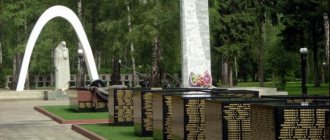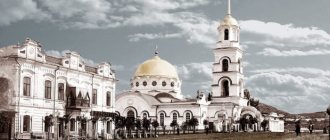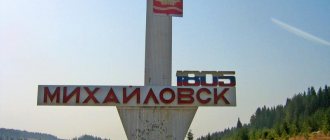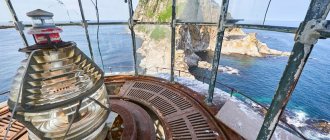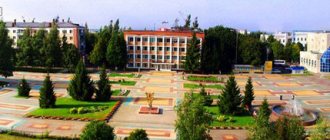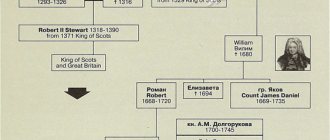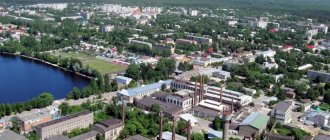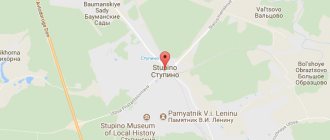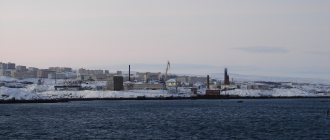From Wikipedia - the free encyclopedia
The history of Novomoskovsk
begins with the village of Bobriki (1765-1930), which in the early 1930s in just a few years became a large industrial city, the capital of the Mosbass territorial region within the Moscow region. This became possible thanks to the construction of a chemical plant for the production of nitrogen fertilizers along with related production and infrastructure. Having suffered greatly during the Great Patriotic War, the city was restored and included in the Tula region, becoming the second largest city in it after the regional center of Tula. The development of scientific research and chemical production has greatly influenced the modern appearance and character of the city.
The city is experiencing its second recovery after the Russian socio-economic crisis of the 1990s. A public-private investment project is of great importance for the city, within the framework of which from 2007 to 2016 it is planned to build new and modernize existing industries, develop transport infrastructure and create conditions for the development of this large industrial area. In 2008, Novomoskovsk became the center of an urban district, which unites 113 settlements of the abolished Novomoskovsky district, and also included the city of Sokolniki.
Source
Population
| Population | ||||||||||
| 1897 | 1926 | 1930 | 1931 | 1932 | 1933 | 1934 | 1939 | 1956 | 1959 | 1962 |
| 13 000 | ↘1000 | ↗14 600 | ↗28 900 | ↗37 700 | ↗60 000 | ↗69 800 | ↗76 186 | ↗109 000 | ↘107 856 | ↗114 000 |
| 1967 | 1970 | 1973 | 1975 | 1976 | 1979 | 1982 | 1985 | 1986 | 1987 | 1989 |
| ↗126 000 | ↗133 892 | ↗142 000 | ↗145 000 | →145 000 | ↗146 807 | ↗147 000 | ↘146 000 | ↗147 000 | →147 000 | ↘146 302 |
| 1990 | 1991 | 1992 | 1993 | 1994 | 1995 | 1996 | 1997 | 1998 | 1999 | 2000 |
| ↘146 000 | →146 000 | ↘145 000 | →145 000 | ↘144 000 | ↘143 000 | ↘142 000 | →142 000 | ↘140 000 | ↘139 600 | ↘138 100 |
| 2001 | 2002 | 2003 | 2004 | 2005 | 2006 | 2007 | 2008 | 2009 | 2010 | 2011 |
| ↘135 300 | ↘134 081 | ↗134 100 | ↘131 700 | ↘129 800 | ↘127 800 | ↘125 700 | ↘124 100 | ↗132 691 | ↘131 386 | ↗143 347 |
| 2012 | 2013 | 2014 | 2015 | 2016 | 2017 | 2018 | ||||
| ↘130 212 | ↘128 902 | ↘127 984 | ↘127 214 | ↘126 479 | ↘125 647 | ↘124 787 | ||||
As of January 1, 2022, in terms of population, the city was in an unknown (impossible to determine the city) place out of 1,115 cities in the Russian Federation.
In 2010, Novomoskovsk was in 126th place in terms of population among Russian cities.
The general demographic dynamics, as throughout the Tula region, are critical.
Sights in Novomoskovsk (Tula region)
60 kilometers southeast of Tula, on the Central Russian Upland, is the second largest city in the region - Novomoskovsk. It is famous for the “source of the Don”, which is located right within the city. It is also the largest concentration of chemical industry enterprises in the country. Therefore, the city is problematic in terms of ecology. The abundant landscaping of Novomoskovsk partially compensates for harmful emissions from chemical plants. The city was built during the USSR, so there are no ancient historical sights in it. However, there are some interesting sites that can be seen in one day.
| Date of foundation of Novomoskovsk: | 1930 |
| City population: | 124,787 people (2018) |
| City area: | 74.7 km² |
Not every city with a population of 100,000 can boast a magnificent children's railway, indoor swimming pools, Ice Palaces (with 3 ice arenas), and its own drama theatre. The city of Novomoskovsk became the first in the Tula region to have an officially registered coat of arms (in 1999).
Novomoskovsk, as a new city, built by the Soviet people from scratch, is distinguished from many other cities by its clear, clearly defined layout of streets and blocks. As well as their exceptionally rich border with green spaces, an abundance of small parks and public gardens. This is protection against emissions from local chemical plants.
Moskovskaya is one of the most beautiful central streets of the city. Its boulevard is planted with apple trees, cherry trees, spruce trees, and decorative rowan trees. There is a large square on it, called Komsomolsky. Next to it is the Palace of Culture, one of the few monumental pre-war buildings that have survived to this day.
Content
- 1Physico-geographical characteristics 1.1Geographical location
- 1.2Time zone
- 1.3Climate
- 1.4Relief
- 1.5Vegetation
- 1.6 Ecological state
- 2.1Modern symbols
- 4.1City leaders
- 6.1Industry
- 7.1Science
- 10.1 Source of the Don
About the history of the city of Novomoskovsk
The city traces its history back to 1930, when the grandiose construction of the chemical industry giant NPO Azot (now NAC Azot) began in these places.
In 1928, the Soviet leadership began accelerated industrialization of the national economy. The new Committee for Chemicalization of the National Economy was given the task of building a number of large chemical plants. Including the production of mineral fertilizers, which were necessary to solve the acute problem of food security in the country of the Soviets in those hungry years.
The site for the construction of this huge plant was determined in September 1929; next to it, it was decided to immediately build from scratch a new city of chemical workers, for 50 thousand people.
Many enthusiasts from many regions of the USSR came to the construction of the chemical plant, who carried out most of the construction work manually - with shovels, wheelbarrows, stretchers. The first settlement of the plant's builders consisted of thousands of dugouts, long common barracks and temporary houses, knocked together from whatever they could find. It was jokingly called “Dig City.”
At the end of December 1933, the chemical plant began producing products, and, having grown many times in size, it still produces: ammonia, ammonium nitrate, urea, methanol, UAN-32, nitrogen-limestone fertilizers.
Then, in December 1933, the city was named Stalinogorsk. In 1934, a state district power station was put into operation here to provide electricity for production, and in 1936 a phenol and aniline dye plant were installed.
Before the debunking of the cult of personality, the city center was decorated with a statue of Stalin
Stalinogorsk also became the center of the Mosbass region as part of the Moscow region. From 1855 to the early 1960s, coal was actively mined in the Tula region, and many mines operated. Subsequently, with the arrival of cheap gas and fuel oil in the region, as well as due to the low quality of coal and the rising cost of its production (water cut), the Mosbass mines began to close.
Stalinogorsk was actively built up with residential buildings and cultural institutions. In particular, the Palace of Culture and medical school were opened in 1935, and the Stalinogorsk Drama Theater in 1938.
During the Great Patriotic War the city suffered greatly. Despite the fact that its occupation lasted only 17 days (late November / early December 1941). Chemical plants and state district power plants were subjected to heavy bombing by fascist aircraft, and the city suffered from them. But most of their equipment was evacuated to the Perm region, the Urals and the Uzbek SSR. Already in 1943, one of the chemical plant’s workshops began operating again, producing the methanol needed by the front.
Social sphere
The science
The main scientific and research organizations of the city:
- Novomoskovsk Institute of Nitrogen Industry (until 1992 - a branch of the State Institute of Nitrogen Industry) - specializes in the design of chemical production, non-standard equipment, energy, engineering and civil construction facilities, and also provides services for the supervision of the start-up, development and bringing production to design level power.
- The Novomoskovsk branch of the Moscow Region Research and Design Coal Institute (PNIUI) specializes in the design and implementation of mining machines and mining hydraulic and electrical equipment in the Moscow Region, Kuznetsk, Pechora, Karaganda and Donetsk coal basins.
- OJSC "Design and Construction Institute Krangormash" (until 1959 - a branch of the Moscow Institute "Giprouglemash" of the USSR Ministry of Coal Industry; later PA "Kran", GPKTI P) - specializes in the development and implementation of new mining machines for the Moscow region coal basin, creation, development and implementation in the industry of special and technological equipment.
Education
Administration of the Children's Railway
As of 2008, the city has 42 secondary schools, 3 boarding schools, an auxiliary school, and 52 preschool institutions. In Novomoskovsk there are the Institute of the Russian University of Chemical Technology, a branch of the University of the Russian Academy of Education, the Novomoskovsk Institute for Advanced Training of Managers and Specialists in the Chemical Industry (GOU DPO "NIPK"), ten secondary specialized educational institutions, medical and music schools, a children's art school, art and music schools, children's railway.
Higher educational institutions issuing state diplomas:
- Novomoskovsk Institute of Russian Chemical Technical University;
- Social and Humanitarian Institute;
- Branch of the University of the Russian Academy of Education;
- Representative office of the Moscow State Transport University (MIIT);
- Institute of Public Utilities.
See also: Educational institutions of Novomoskovsk
Culture and media
Palace of Children's and Youth Creativity.
In Novomoskovsk there is a drama theater named after. V. M. Kachalina, a cinema, an art salon and an exhibition hall, 28 palaces and houses of culture, 8 clubs. 5 newspapers are published (the oldest newspaper in the city, Novomoskovskaya Pravda, has been published since 1930).
The municipal budgetary cultural institution "Novomoskovsk Library System" united the central city, children's, 9 city branch libraries and 9 rural libraries.
A municipal symphony orchestra has been created in the city, which has performed in cities in Russia, Greece, Italy, Spain and Poland.
Participant in the liberation of the city in 1941 - BM-13-16 at the entrance to the Historical and Art Museum.
The Novomoskovsk Historical and Art Museum presents an exhibition about the history of the city; it regularly hosts art exhibitions. The museum also includes a museum and exhibition center and a branch - the archaeological museum.
There are cinemas "Azot" (with 900 seats), "Pobeda", and "Illizium".
A television
| External images | |
| Novomoskovsk TV tower. | |
The city has a municipal television and radio company, a private television company, cable television, and 6 radio stations. Digital television broadcasting is also developed in Novomoskovsk.
The city also has a television center with its own television tower (RTPS) 180 m high. Until 1992, regional television broadcast from here, and not from the regional center - the city of Tula. Currently, 8 TV channels and 7 radio stations broadcast from RTPS.
On-air digital TV channels are broadcasting:
| № | First Multiplex |
| 1 | "First channel" |
| 2 | "Russia 1" |
| 3 | "Match TV" |
| 4 | "NTV" |
| 5 | "Channel Five" |
| 6 | "Russia K" |
| 7 | "Russia 24" |
| 8 | "Carousel" |
| 9 | "OTR" |
| 10 | "TV Center" |
| 1 | "Radio Russia" |
| 2 | "Radio Mayak" |
| 3 | "Vesti FM" |
| № | Second Multiplex |
| 1 | "REN TV" |
| 2 | "Saved" |
| 3 | "STS" |
| 4 | "Home" |
| 5 | "TV3" |
| 6 | "Friday" |
| 7 | "Star" |
| 8 | "WORLD" |
| 9 | "TNT" |
| 10 | "Muz TV" |
Radio stations
| Frequency | Radio station |
| 72.35 | Radio Russia / GTRK Tula |
| 87.7 | Hit-FM |
| 88.1 | Radio Dacha |
| 103.0 | New radio |
| 106.6 | Police wave |
| 107.9 | Autoradio |
Sights of the Children's Park
The children's park in Novomoskovsk is a beautiful, abundantly landscaped architectural and natural complex. It is located in the central part of the city and covers an area of more than 27 hectares. This is an ideal place for relaxing and walking with children: many cozy shady alleys, well-equipped playgrounds, and attractions. There is a cascade of ponds.
Voivode Chernomor with his squad in the Children's Park
Physiographic characteristics
Geographical position
Novomoskovsk and surrounding area, LandSat-7 satellite image (September 23, 2006).
The city is located at an altitude of 236 meters above sea level, between the Don and Shat rivers, 220 kilometers south of Moscow and 60 kilometers southeast of the regional center of Tula. Within the boundaries of Novomoskovsk is the source of the Don River. In close proximity to Novomoskovsk there are the cities of Donskoy (in the south and southeast) and Uzlovaya (in the southwest).
The area of the city without adjacent rural areas is 76 km². The urban district covers an area of 888 km². On the territory of the urban district there are two large reservoirs - Shatskoye and Pronskoye, which were built to supply water to large enterprises, as well as Lyubovskoye - a cooling reservoir for the Novomoskovskaya State District Power Plant, which is used for fishing needs.
Timezone
The city of Novomoskovsk, like the entire Tula region, is located in a time zone designated by international standard as the Moscow Time Zone (MSK). The offset relative to UTC is +3:00.
Climate
The climate is moderate continental. Summer is quite warm, the average temperature in July is about +18 °C. Winter is moderately cold, the average temperature in January is between –9…–10 °C. The annual precipitation is about 600 mm, of which 36% falls in summer, 26% in autumn, 20% in winter, and 18% in spring. The main wind directions are southern, western and southwestern.
Relief
The relief of the Central Russian Upland, on which Novomoskovsk is located, is erosive in nature - gully-beam-valley, with a density of dissection up to 1.3-1.7 m per 1 km² and a depth of 50 m to 100-150 m, in some places karst is developed. Forest-steppe and steppe predominate. The territory of the region is heavily plowed under agricultural land.
Vegetation
The first of a cascade of artificial reservoirs in the Novomoskovsk children's park.
Scheme map of the Children's Park in Novomoskovsk. The forest fund of the Novomoskovsky district makes up only 5% of the total area of the territory, and is represented by separate tracts remaining from the once powerful tracts - Kryukovsky forest, Urvansky forest, etc., where broad-leaved tree species grow: maple, linden, ash, occasionally oak, as well as aspen, birch. All forest plantations are artificial. Larch trees are also planted in the parks located in the central part of the city - Birch Grove and Children's Park. Poplars were used for landscaping streets and courtyards. In 2005, the poplars were cut down. Also on the territory of Novomoskovsk there is a so-called “Adult Park” in which mainly deciduous trees are planted.
Each resident has up to 300 m² of green space, which significantly exceeds this urban planning requirement.
The soils of the urban district are predominantly represented by medium-deep chernozems.
Ecological state
Novomoskovsk traditionally has an acute environmental situation due to emissions of harmful substances into the atmosphere by the city's chemical industry enterprises.
| External images | |
| Map of radiation contamination of the Tula region with cesium-137 (IBRAE RAS) | |
In 1986, the territory of the city and district, like a number of other territories of the Tula region (mainly in the zone south of Tula from west to east of the region), suffered serious radioactive contamination as a result of the disaster at the Chernobyl nuclear power plant. The city belongs to territories with preferential socio-economic status.
Toy railway
The Novomoskovsk railway for children, located in the city Children's Park, is rightfully considered the best such entertainment facility in our country and is the pride of the city.
The local children's railway dates back to 1953; since then it has undergone a lot of reconstructions and modernizations. Its entire infrastructure is made as close to real as possible and very comfortable for children. In 2011, a major reconstruction was carried out on the Russian Railways, during which a new stop point Istok Dona appeared, and the depot and Berezki station underwent major repairs.
All the duties of Russian Railways employees are performed here by children - schoolchildren from middle and high schools who have undergone special training.
Toy railway
The length of the railway ring that encircles the Children's Park is two kilometers. Everything on the Russian Railways is arranged like an adult: trains give signals, run in strict accordance with the schedule, stations and railway switches are properly organized.
The children's railway is conveniently located - in the city center, next to various attractions and other entertainment for children. Her visit is a real holiday. And not only for children, but also for their parents. And also for newlyweds: a specially equipped wedding carriage is at their service.
Economy
Industry
The Novomoskovsk region has developed chemical, energy and food industries, the construction industry, agriculture, railway and road transport. The volume of shipped goods of own production in manufacturing in 2008 amounted to 53.5 billion rubles. The city belongs to the polycentric Tula-Novomoskovsk agglomeration.
Novomoskovskaya GRES.
The city occupies one of the leading places in the country in the production of mineral fertilizers and a number of other types of chemical products (79% of shipped goods). There are more than 100 industrial enterprises and construction organizations operating in the city and region. The largest in the industry of the city and region are JSC Novomoskovskaya Joint Stock Company, JSC Orgsintez, LLC Poliplast Novomoskovsk, JSC Polimercontainer, JSC Knauf-Gips, State District Power Plant of the Quadra branch - Tula Regional Generation, Aerosol Novomoskovsk. , Novomoskovsk Plant of Ceramic Materials - , GOTEK-, and others.
In agricultural production, crop production and livestock farming are developed. Features in the development of livestock farming is the breeding of livestock and poultry on an industrial basis. In the Novomoskovsk region, grain crops, sugar beets, potatoes, vegetables, berries and fruits are grown. As of July 2009, the agro-industrial complex of the city of Novomoskovsk includes: agricultural enterprises, 3 subsidiary farms, 46 farms, as well as household farms.
In the Novomoskovsk urban district there are the largest deposits of stone gypsum in Europe, deposits of coal, pyrite, clay for brick and ceramic production, as well as limestone and loam.
In 2007, Novomoskovsk won the All-Russian Golden Ruble competition as the most economically developed among small cities. In the same year, the Novomoskovskinvest corporation was formed in Novomoskovsk, which is implementing the largest domestic investment project to create an industrial and economic cluster in the city. The project's business plan includes the construction of new production facilities, as well as transport and engineering infrastructure.
Novomoskovsk is one of the most comfortable Russian cities: according to the results of the All-Russian competition for improvement, the city took third place twice in a row (1997 and 1998).
Trade
Food products - “Liniya”, “SPAR”, “Magnit”, “Dixie”, “Pyaterochka”, “Perekrestok”, “Carousel”, “U Palych”, “Verny”, “DA!”, “Atak”. Novomoskovsk has stores of the largest Russian retail chains, modern shopping centers are open, and there are two markets.
- Alcohol products - “Red and White”, “Bristol”, “Gradus”.
- Construction and repair - TMK.
- Jewelry stores - “Adamas”, “Jasper Gold”, “Pandora”, “Diamond Hand”.
- Children's products - “Korablik”, “Dochki Sonochki”, “IQTOY.Correct Toys”, “Lego”, “Children”, “Children’s World”.
- Sports - “Dispute.
- Cellular communication stores - Euroset, Svyaznoy, TELE2, MTS, Beeline, Megafon, Yota.
- Entertainment - "Happy Land".
- Cosmetics and perfumes - L'Etoile, Yves Rocher.
- Optics - "OKVision".
- Clothing - “O'STIN”, “INCITY”, “Gloria Jeans”, “Concept Club”, “Zolla”, “Takko Fashion”, “Snowimage”, “Sir”.
- Trading, "Passage", "Milan", "Talisman".
- Markets - “(formerly “Urvansky”).
Transport
The request “Novomoskovsk city train” is redirected here. A separate article should be created on this topic.
Yellow minibus No. 125 on Moskovskaya Street.
| External images | |
| Traffic diagram of city bus routes. | |
| Electric train traffic diagram. | |
| Photo of the Novomoskovsk railway junction. | |
City public transport of Novomoskovsk is represented by the city train, referred to among local residents as the “Novomoskovsky Ring”, bus and minibus.
Near the city there are highways M4 E 115 "Don", P132 Kaluga - Tula - Mikhailov - Ryazan, Tula - Novomoskovsk, the Moscow - Donbass and Syzran - Vyazma railways. The main station of the city is Novomoskovsk-1.
Railway transport
The city electric train line Maklets - Novomoskovsk-1 - Bobrik-Donskoy has a length of 25 kilometers. There are a total of 12 stations and stopping points (10 in Novomoskovsk and 2 in Donskoy). Travel time on the main line is about 55 minutes. The lines of the Novomoskovsk railway junction are intended primarily for passenger transportation: delivery of workers from the southern residential area of Novomoskovsk to the northern industrial area, as well as travel of city residents to their summer cottages. In addition to electric trains, which carry out the bulk of intracity passenger transportation, passenger traffic is also carried out by diesel trains, which provide suburban connections with other cities in Tula and neighboring regions.
Toy railway
Diesel locomotive TU10 with a children's railway train
Main article: Novomoskovsk children's railway
The children's railway runs in a closed ring around the children's park, founded in the early years of the city's foundation, and is one of the main city attractions. As of 2009, it was the best children's railway in Russia in terms of performance indicators. The initiator of the construction of the children's railway was the director of the Moscow Coal plant D. G. Onika in 1953. The children's railway is equipped with automatic track blocking, telephone and radio communications. The fleet has two diesel locomotives of the TU10 model and 5 passenger cars of the VP-750 model. Previously, diesel locomotives TU2 and passenger cars PV51 were in operation; now one of the two surviving diesel locomotives TU2 is under conservation, and the other is installed as a monument. After the joint work of the administration of the Novomoskovsk Children's Railway and the city's youth policy committee, the last carriage became a “wedding” carriage, in which the newlyweds take their first honeymoon.
Tourism
Hotel "Russia".
Novomoskovsk has three hotels.
| Category | Hotel name |
| Hotel "New Hostel" | |
| Hotel "October" | |
| Hotel "Russia" |
Source of the Don
Of course, the great Russian river Don has several sources. Initially, it generally flowed out of Ivan Lake, which was absorbed in the 1930s by the man-made Shatsky reservoir. It is not located in the Children's Park of Novomoskovsk, but six kilometers northeast of it. Another natural source of the Don is the Urvanka River, which from time immemorial flowed near Ivan Lake and was fed by underground springs emerging from limestone rocks near the village of Urvanki.
Therefore, the Source of the Don in the Children's Park of Novomoskovsk is nothing more than an allegory, a special tourist attraction, a “calling card” of the city. The stone from under which the “source of the Don” flows was erected here in 2000, and the water there flows not from an underground spring, but from the city water supply network.
The bed of the man-made stream then stretches under the pedestrian bridge, under the rails of the children's railway, goes deep into the park, and then gets lost somewhere in the grass. However, the water from it, as well as from the cascade of man-made ponds in the Children’s Park, then actually flows into the Urvanka River (now very swampy in places, in places turning into a barely noticeable stream). And from it - to the Don.
Religion
See also: Temples of Novomoskovsk
The city has temples of various religious denominations. In 1992, the first Orthodox church in Novomoskovsk was consecrated, dedicated to the Feast of the Intercession of the Blessed Virgin Mary. Two years later, in 1994, on the day of the Battle of Kulikovo, the Holy Dormition Church was opened. In 1995, by decree of the Synod of the Russian Orthodox Church, the Holy Dormition Monastery was founded. In the same year, a monastery was opened in the village of Klin, where hermit monks found shelter. In 1997, in the building of the former “Vstrechny” cinema, another church was opened in honor of the “Unexpected Joy” icon of the Mother of God.
In 2009, the Cossack society of the city of Novomoskovsk decided to build an Orthodox church on the territory of the Children's Park next to the architectural complex “Istok Dona”.
Also in the village of Spassky there is the Holy Spassky Church, opened in 1813 and which is an architectural monument. There is a Sunday school at the church.
Temples of other Christian denominations include the Seventh-day Adventist Church, the Evangelical Christian Church and the Pentecostal Church of the Evangelical Christians.
Presbyterians and charismatics are also represented in the city.
Sculptural composition “Don and Shat”
Near the Source of the Don in Novomoskovsk there is a sculptural composition that represents two naked boys on horses. One of them has a disk in his hand. You might think it's a tambourine. But in fact, according to the plans of the sculptors Syromyatnikov and Smirnov, this is the Sun, from which the boy shaded his eyes with his palm.
The boys symbolize the Don and Shat rivers, which in ancient times flowed in the form of streams from Lake Ivan. The winding Shat winds through the Tula region and flows into the Upa River, and the straight Don goes south, where it turns into a full-flowing iconic Cossack river.
Sculptural composition “Don and Shat”
The sculptural composition, made in 1989, was inspired by Leo Tolstoy’s fairy tale “Don and Shat,” which the classic wrote based on an ancient Russian legend. Previously, it stood in a different place in the park and was not very visible because of the trees.
Sport
City sports facilities:
- Novomoskovsk College of Physical Culture and Sports (in 1966-1993 - physical education secondary specialized educational institution "Novomoskovsk College of Physical Culture") trains specialists in the specialty "Teacher of Physical Culture and Sports";
- two children's and youth sports schools No. 1 and No. 2 in Novomoskovsk and one in Sokolniki;
- city swimming pool;
- chess and checkers club;
- shooting club "Sniper";
- Palace of Sports;
- Khimik stadium;
- FOTS "Olympus" (Central district), FOTS "Olympus-2" (Northern microdistrict) and FOTS "Olympus-3" (Zalesny microdistrict).
Since 1954, the city has had a football club “Khimik”, which plays in the PFL Championship. In 1956-1957 the club represented Mosbass. From 1980 to 1992 he did not participate in the national championships. From 1993 to 2009 it was called “Don”. In the 2007 season, FC Don took last, 16th place in the second division and lost its professional status, and in 2009 refused to participate in the LFL tournament. The home stadium is “Khimik” with a capacity of 5,200 spectators.
On May 20, 2011, the Yubileiny Ice Palace was opened with the support of.
Novomoskovsk Drama Theater
The Stalinogorsk Drama Theater was founded on January 30, 1938, on the basis of an amateur association of enthusiasts - the Theater of Working Youth (TRAM).
Since 1989, the drama theater has been located in the building of the former House of Scientific and Technical Information of the former Novomoskovskugol association. The theater auditorium has 300 seats. Before this, the theater staged its performances on the stage of the Palace of Culture of Chemists.
The theater staff takes an active part in the cultural life of many cities in the region. In his youth, People's Artist of the USSR Innokenty Smoktunovsky played on its stage.
Novomoskovsk Drama Theater
Since 1999, the Novomoskovsk Drama Theater has been named after Vladimir Kachalin, an honorary citizen of the city who played more than 300 roles in this cultural institution.
The theater's current repertoire includes more than twenty adult and about ten children's performances for every taste, from timeless classics to light and unassuming vaudeville comedies.
Novomoskovsk Historical and Art Museum and "Katyusha"
The museum was opened on May 8, 1966, and was initially entirely dedicated to the Great Patriotic War. Subsequently, new thematic expositions and exhibitions were launched there: dedicated to the construction of the Stalinogorsk Chemical Plant and the city itself, and the revival of industry after the war.
Since 2001, the museum is not a local history museum, but a historical and artistic one. It periodically organizes temporary exhibitions of artists and sculptors, masters of applied arts; collections of numismatics, sea shells, etc., etc.
Novomoskovsk Historical and Art Museum and "Katyusha"
Gallery
| External images | |
| Photo of Novomoskovsk. | |
- The central square of the city is Sovetskaya Square.
- The intersection of Berezovaya Street and Komsomolskaya Street in the central area of the city.
- Railway crossing in Novomoskovsk on the road to Tula and Uzlovaya.
- Novomoskovsk Drama Theater named after. V. M. Kachalina.
- Monument to the Stalinogorsk participants of the Great Patriotic War.
- Eternal flame and monument to those killed in the Great Patriotic War (Moskovskaya St.).
- Memorial to those who fell in the Great Patriotic War, Memory Park in the Urvan Forest.
- Memorial complex in memory of the heroes who died in the battles for Stalinogorsk, and of all Novomoskovsk residents who did not return from the front.
Novomoskovsk Archaeological Museum
Since archaeological excavations are regularly carried out in the vicinity of Novomoskovsk, the finds of these expeditions of the local scientist Oleg Zaidov formed a separate archaeological museum. Its exhibition is located in two exhibition halls. One of them contains a collection of artifacts dedicated to the ancient past of the region - from the Stone Age to the 17th century. In the other, finds from the Great Patriotic War are presented, entertaining lectures and interactive programs are held.
Novomoskovsk Archaeological Museum
Palace of Culture
The Palace of Culture of Chemists - the main center of culture of Stalinogorsk - was built, like the whole city, at an accelerated pace: in 1935-1936. this rather large building was erected. Amateur artistic groups, party and Komsomol conferences immediately started working there, and the local theater gave performances and showed films in the auditorium. The entire third floor of the building was occupied by a large library with a reading room. In 1954, it was moved out of it into its own separate building.
During the Great Patriotic War, conscripts and militias gathered in front of the Palace of Culture, from here they went to the front. During the 17-day occupation, German soldiers, right in the middle of the auditorium of the Palace of Culture, lit a fire from its chairs and warmed themselves. But in general, the building of the Palace of Culture was relatively well preserved in the war-ravaged city, and resumed work already in 1942.
Nowadays, the Palace of Culture lives an active creative life: every year it holds up to hundreds of concerts, festive evenings, competitions, entertainment programs, performances for all age categories of residents of the city and region.
Source
Architecture
| External images | |
| Stalinogorsk architecture. Series of photographs. | |
The central part of the city is characterized by a strict arrangement of streets running relative to each other at right angles according to the original development plan. The city center is Sovetskaya Square. Facing the square is the building of the Moscow Region Coal Research Institute. Next to it is a large four-story building with columns, which houses the municipal assembly and the administration of the city and district. The main street of the city, Komsomolskaya, runs through the square. A little to the east it is crossed by Moskovskaya Street, the widest in the city. Together, these two streets set the direction from the center and are a kind of “face” of the city.
The central area combines pre-war, post-war and modern architecture. Among the pre-war buildings, houses with arches, buildings in the constructivist style, for example, the building of the Pobeda cinema on the central square of the city, or a high-rise building with a colonnade on the street, stand out. Moscow. Famous architects, the Vesnin brothers, took part in the implementation of the construction plan.
During the Great Patriotic War the city was severely destroyed. German prisoners of war took part in the restoration of the city. Post-war buildings, in particular, include the building of the drama theater, the building of the city committee (now the city administration), two-story residential buildings built in the post-war years.
The streets are decorated with many green spaces.
- Sculpture of a miner near the PNIUI building on Sovetskaya Square
- Cinema "Pobeda"
- Stalin's skyscraper "Tower"
- Rotunda on the boulevard along Komsomolskaya street
History of Novomoskovsk
History of Novomoskovsk
originates from the village of Bobriki (1765-1930), which in the early 1930s in just a few years became a large industrial city, the capital of the Mosbass territorial region as part of the Moscow region. This became possible thanks to the construction of a chemical plant for the production of nitrogen fertilizers along with related production and infrastructure. Having suffered greatly during the Great Patriotic War, the city was restored and included in the Tula region, becoming the second largest city in it after the regional center of Tula. The development of scientific research and chemical production has greatly influenced the modern appearance and character of the city.
The city is experiencing its second recovery after the Russian socio-economic crisis of the 1990s. A public-private investment project is of great importance for the city, within the framework of which from 2007 to 2016 it is planned to build new and modernize existing industries, develop transport infrastructure and create conditions for the development of this large industrial area. In 2008, Novomoskovsk became the center of an urban district, which unites 113 settlements of the abolished Novomoskovsky district, and also included the city of Sokolniki.
Local government
Administration building of Novomoskovsk.
Novomoskovsk is an independent municipal entity within the Tula region - a city district. Its official name is the municipal formation of the city of Novomoskovsk.
Local self-government is carried out on the basis of the charter.
The representative body of local self-government is the meeting of deputies
. It consists of 25 deputies elected in municipal elections for a period of 5 years. It is headed by the head of the municipality, elected by deputies from among its members.
On November 23, 1997, the first municipal elections were held, at which the Head of the municipality and the Municipal Council were elected. The first popularly elected head of the city and district was Nikolai Nikolaevich Minakov. Since May 2009, the head of the municipality has been Elena Anatolyevna Kozina.
The executive and administrative body of local self-government is the administration
. It is formed and headed by the head of the administration, who is appointed under a contract concluded based on the results of a competition for a period of 5 years. In 1991, with the beginning of the transition to local self-government, the governor of the Tula region appointed Stanislav Alekseevich Shedenkov as head of the administration of Novomoskovsk and the Novomoskovsky district. Since June 1, 2009, the duties of the head of the administration have been performed by Vadim Anatolyevich Zherzdev.
Heads of the city
- Minakov, Nikolai Nikolaevich (December 1997 - April 2009)
- Tsoi, Anatoly Davidovich (April-May 2009, acting chairman of the meeting of deputies)
- Kozina, Elena Anatolyevna (May 2009 - September 19, 2013)
- Prorokov, Anatoly Evgenievich (from September 20, 2013)
Heads of the city administration
- Shedenkov, Stanislav Alekseevich (1991-1996)
- Minakov, Nikolai Nikolaevich (June 1996 - November 13, 2008)
- Potapov, Igor Mikhailovich (from November 13, 2008 - April 2009)
- Zherzdev, Vadim Anatolyevich (acting from June 1, 2009, from December 25, 2009 to 2022)
- Biryulin, Alexey Alekseevich (September 2022 - present)
Bobriki village
Novomoskovsk arose as the village of Bobriki
- the estate of the noble family Bobrinsky, illegitimate descendants of Count Orlov and Empress Catherine II. In 1765, the village of Bobriki, together with the village of Bogoroditskoye (now the city of Bogoroditsk), formed Catherine II’s own volost. Administratively, the village of Bobriki was part of the Epifansky district of the Tula province, and the territory of the current urban district of Novomoskovsk was divided between the Epifansky, Bogoroditsky and Venevsky districts.
| External images | |
| Photos of the historical and memorial museum complex "Bobriki". | |
Construction of a chemical plant
The city was founded in 1930 as the city of Bobriki
Uzlovsky district, Moscow region. It owes its appearance to the construction of the chemical giant NPO Azot (now NJSC Azot), as well as the development of the Moscow region coal basin.
Prerequisites for the emergence of the city
“Super-impact” construction of the first five-year plan
| External images | |
| The City Palace of Culture was opened in 1936. | |
| Soviet Square (before the war) with a monument to Stalin. | |
| Views of the city. From left to right - the main streets: Moskovskaya, Komsomolskaya and their intersection in the center. | |
| Moskovskaya street with the railway. | |
| The building of the old station on Moskovskaya street. | |
| Old photos of the city. | |
City of Chemists
At the same time, with the start of construction of industrial facilities, construction of a residential area in the city of chemists began. Presumably, on the initiative of P. G. Harutyunyants, [12] housing and cultural and social facilities began to be built in the southern part, at a distance of 12 kilometers from the industrial zone. This idea caused a negative reaction in the leadership: due to concerns about creating a healthy air environment for residents, the cost of the project to create transport links between the southern and northern parts of the city increased. As a result, the project was nevertheless implemented, but at the end of the 1930s the entire group of architects was accused of sabotage and repressed, and P. G. Harutyunyants himself was sentenced to death in 1938 for sabotage activities (posthumously rehabilitated in 1955).
Administrative structure
The city has a complex planning structure that developed back in Soviet times and consists of two large planning areas, separated by a significant sanitary protection zone:
- The southern planning area
is the main residential area of the city, in which the urban center is located; - The Northern planning area
is the area of the main production sites of the city, and it also contains housing stock located in the sanitary protection zone of the Northern Industrial Hub.
| External images | |
| Map of the Moscow Region city of Novomoskovsk. | |
| Map of the Novomoskovsk Urban District. | |
Districts of the southern part of the city:
- The central historical part of the city - 4 central microdistricts;
- The North-Western district (conventional name) is located to the west of the historically formed part of the city and to the east of the settlement of Kamenetskoye, includes Urvan microdistricts 1-6, the Northern microdistrict, mine villages No. 26 and No. 22;
- Gypsum microdistrict (until 2008 - a gypsum plant village);
- The 1st Zalesny microdistrict is located in the eastern part of the city;
- The 2nd Zalesny microdistrict is located in the eastern part of the city;
- The Lugovaya microdistrict is located east of the street. Labor reserves;
- The Vakhrushevo district is located southeast of the intersection of Vakhrushev and Kosmonavtov streets (named in honor of V.V. Vakhrushev);
- The southern district (conventional name) is located south of the 13th and 16th quarters and is divided by the street. Mayakovsky, includes the microdistricts (villages) Klin, Shamotny, Zapadny, MOGES.
Microdistricts of the new general plan (as of 2009):
- 3rd Zalesny microdistrict (construction has begun);
- 4th Zalesny microdistrict (planned construction);
- Lyubovsky microdistrict (construction planned).
During the Great Patriotic War
Under martial law
| External images | |
| Breakthrough of German troops to Stalinogorsk - Venev. November 18, 1942. | |
| Monument to the soldiers who died for the liberation of the city of Stalinogorsk in 1941. May 1951. | |
Defense of Stalinogorsk
According to the memoirs of the commander of the 2nd Panzer Army G. Guderian, [27] “On November 26, the 53rd Army Corps approached the Don, crossed it with the forces of the 167th Infantry Division at Ivan Lake and attacked the Siberians [note 4] northeast of this settlement near Donskoy. The valiant division captured 42 guns, a number of vehicles and up to 4,000 prisoners. From the east, the 29th Motorized Division of the 47th Tank Corps attacked the Siberians, as a result of which the enemy was surrounded.”
City under occupation
Liberation
At dawn on December 11, the Stalinogorsk underground fighters carried out an operation to defeat the German headquarters, as a result of which, according to General P. A. Belov, “control of the enemy troops was disrupted for some time.” [34]
Restoration of the city and industry
Stalinogorsk! He endured all the torment Because he bore the name of Stalin: His enemies twisted his arms. They crushed the bones, tore the ligaments of the veins, but he didn’t say a word - he survived in silence.
Source
